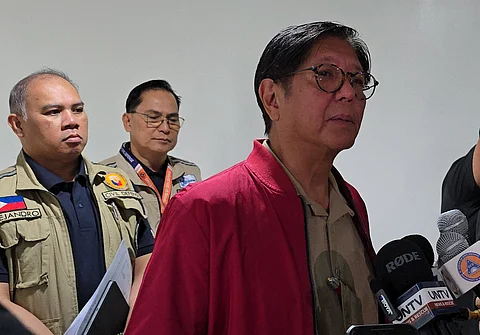
- NEWS
- the EDIT
- COMMENTARY
- BUSINESS
- LIFE
- SHOW
- ACTION
- GLOBAL GOALS
- SNAPS
- DYARYO TIRADA
- MORE

“Unfortunately, we are at the mercy of the weather,” President Ferdinand R. Marcos Jr. remarked, as he urged Filipinos to shift their mindset about typhoons hitting the country.
Marcos, speaking to reporters in an ambush interview at the Office of the Civil Defense (OCD) headquarters in Camp Aguinaldo on Thursday, stressed that extreme weather events should no longer be seen as rare emergencies but as a regular and expected part of life in the Philippines.
He called on the public to adopt a culture of preparedness, treating typhoons not as surprises but as inevitable realities.
“I also explained once again, it's not the first time I've done it, we have to explain that huwag na—palitan na natin ang pag-iisip natin, hindi ito unusual, hindi ito emergency, ito na ngayon talaga ang panahon. Mangyayari ito (we need to change our mindset. This is not unusual, this is not an emergency, this is really the reality now. This will happen),” Marcos said.
According to the President, forecasts estimate that the country may experience between 10 and 15 typhoons this year.
With three already recorded, he warned that the nation should expect up to a dozen more storms in the months ahead.
“Ang sinasabi ng estimate daw sa bagyo para sa taon na ito 10 to 15 na bagy, So nakatatlo na tayo. So to be conservative, ibig sabi, isang dosena pa ito na dadating (The estimate for typhoons this year is said to be around 10 to 15. We've already had three. So, to be conservative, that means about a dozen more are still coming),” he added.
Marcos noted how traditional expectations about weather patterns, such as clear typhoon seasons and known flood-prone areas, no longer hold.
Climate unpredictability, he said, now requires more adaptable, long-term thinking from both the government and the public.
“Tayo kasi, nung lumaki tayo maliwanag na maliwanag kung kailan ang typhoon season. Maliwanag na maliwanag kung saan nagbabaha. Ngayon hindi na ganun, nagbago lahat (For us, when we were growing up, it was very clear when the typhoon season was. It was very clear where flooding would occur. Now it's not like that anymore—everything has changed),” Marcos stressed.
He continued. “And we have to see that—'Wag na natin sasabihin baka magkabagyo. Papaano na pagdating ng bagyo dahil darating at darating ‘yan (We should no longer say that a storm might hit us. What if a typhoon comes because it will come). That is the fact of climate change, and we are now having to think more.”
Marcos underscored the importance of both mitigation and adaptation strategies. He emphasized that the government continues to provide emergency response, including deploying doctors, medicines, rubber boats, and relief goods to flood-affected areas.
He also emphasized the need to establish more permanent solutions, such as robust evacuation centers and robust healthcare infrastructure, to prepare for future disasters.
“But we have to make those arrangements almost semi-permanent because, this is going to, as I said, this is going to happen. As I told them today, this will happen this year, it will happen next year, it will happen the year after that,” he said.
Despite current challenges, including areas still inaccessible due to floodwaters, Marcos said that disaster response efforts are improving, citing the use of lessons learned from previous storms.
“So we’re just continuing to do what we always do, and so far, we are using the lessons that we learned from the previous storms, and it is serving us well. And I hope that the weather gets better,” he said.
Marcos earlier led the situation briefing with member agencies of the National Disaster Risk Reduction and Management Council (NDRRMC).
